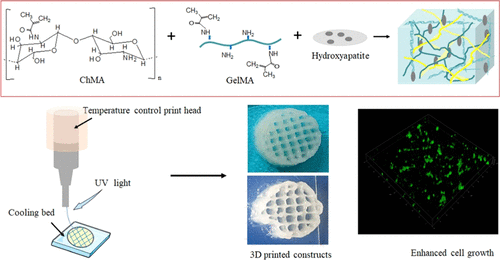当前位置:
X-MOL 学术
›
ACS Appl. Mater. Interfaces
›
论文详情
Our official English website, www.x-mol.net, welcomes your
feedback! (Note: you will need to create a separate account there.)
Three-Dimensional-Printable Thermo/Photo-Cross-Linked Methacrylated Chitosan–Gelatin Hydrogel Composites for Tissue Engineering
ACS Applied Materials & Interfaces ( IF 8.3 ) Pub Date : 2021-05-07 , DOI: 10.1021/acsami.1c01321
Amarachi Rosemary Osi 1, 2 , Hua Zhang 1 , Jing Chen 1 , Yang Zhou 1 , Rong Wang 1 , Jun Fu 3 , Peter Müller-Buschbaum 4, 5 , Qi Zhong 4, 6
ACS Applied Materials & Interfaces ( IF 8.3 ) Pub Date : 2021-05-07 , DOI: 10.1021/acsami.1c01321
Amarachi Rosemary Osi 1, 2 , Hua Zhang 1 , Jing Chen 1 , Yang Zhou 1 , Rong Wang 1 , Jun Fu 3 , Peter Müller-Buschbaum 4, 5 , Qi Zhong 4, 6
Affiliation

|
Biomimetic constructs imitating the functions, structures, and compositions of normal tissues are of great importance for tissue repair and regeneration. Three-dimensional (3D) printing is an innovative method to construct intricate biomimetic 3D tissue engineering scaffolds with spatiotemporal deposition of materials to control the intrinsic architectural organization and functional performance of the scaffold. However, due to the lack of bioinks with suitable printability, high structural integrity, and biological compatibility, producing constructs that mimic the anisotropic 3D extracellular environments remains a challenge. Here, we present a printable hydrogel ink based on methylacrylate-modified chitosan (ChMA) and gelatin (GelMA) embedding nanohydroxyapatite (nano-Hap). This polymer composite is first physically cross-linked by thermal gelation for postprinting structural stability, followed by covalent photo-cross-linking of ChMA and GelMA to form a long-term stable structure. The rheological behavior of the hydrogels and the mechanical strengths of the printed constructs are tuned by adjusting the content of GelMA, which in turn enhances the shape retention after printing and enables the precise deposition of multilayered 3D scaffolds. Moreover, the formulated biomaterial inks exhibit biological characteristics that effectively support the spreading and proliferation of stem cells seeded on the scaffolds after 7 days of in vitro culture. Adding Hap has minor influences on the mechanical rigidity and cytocompatibility of the hydrogels compared with the group free of Hap. Together, the printable biomaterial inks with shear thinning and good structural integrity, along with biological cues, are promising for tissue engineering application.
中文翻译:

用于组织工程的三维可打印热/光交联甲基丙烯酸化壳聚糖-明胶水凝胶复合材料
模仿正常组织的功能、结构和组成的仿生结构对于组织修复和再生非常重要。三维 (3D) 打印是一种创新方法,可以构建复杂的仿生 3D 组织工程支架,并通过材料的时空沉积来控制支架的内在结构组织和功能性能。然而,由于缺乏具有合适的可印刷性、高结构完整性和生物相容性的生物墨水,生产模拟各向异性 3D 细胞外环境的构造仍然是一个挑战。在这里,我们提出了一种基于丙烯酸甲酯改性壳聚糖 (ChMA) 和明胶 (GelMA) 嵌入纳米羟基磷灰石 (nano-Hap) 的可印刷水凝胶墨水。这种聚合物复合材料首先通过热凝胶进行物理交联,以实现印后结构稳定性,然后通过 ChMA 和 GelMA 的共价光交联形成长期稳定的结构。水凝胶的流变行为和打印结构的机械强度通过调整 GelMA 的含量来调整,这反过来又增强了打印后的形状保持性,并使多层 3D 支架的精确沉积成为可能。此外,配制的生物材料墨水表现出的生物学特性可有效支持在体外培养 7 天后种植在支架上的干细胞的扩散和增殖。与不含 Hap 的组相比,添加 Hap 对水凝胶的机械刚度和细胞相容性的影响较小。一起,
更新日期:2021-05-19
中文翻译:

用于组织工程的三维可打印热/光交联甲基丙烯酸化壳聚糖-明胶水凝胶复合材料
模仿正常组织的功能、结构和组成的仿生结构对于组织修复和再生非常重要。三维 (3D) 打印是一种创新方法,可以构建复杂的仿生 3D 组织工程支架,并通过材料的时空沉积来控制支架的内在结构组织和功能性能。然而,由于缺乏具有合适的可印刷性、高结构完整性和生物相容性的生物墨水,生产模拟各向异性 3D 细胞外环境的构造仍然是一个挑战。在这里,我们提出了一种基于丙烯酸甲酯改性壳聚糖 (ChMA) 和明胶 (GelMA) 嵌入纳米羟基磷灰石 (nano-Hap) 的可印刷水凝胶墨水。这种聚合物复合材料首先通过热凝胶进行物理交联,以实现印后结构稳定性,然后通过 ChMA 和 GelMA 的共价光交联形成长期稳定的结构。水凝胶的流变行为和打印结构的机械强度通过调整 GelMA 的含量来调整,这反过来又增强了打印后的形状保持性,并使多层 3D 支架的精确沉积成为可能。此外,配制的生物材料墨水表现出的生物学特性可有效支持在体外培养 7 天后种植在支架上的干细胞的扩散和增殖。与不含 Hap 的组相比,添加 Hap 对水凝胶的机械刚度和细胞相容性的影响较小。一起,

































 京公网安备 11010802027423号
京公网安备 11010802027423号